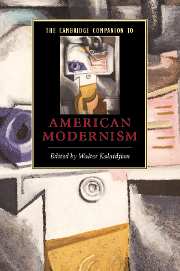Introduction
Published online by Cambridge University Press: 28 May 2006
Summary
Slightly ahead of his time, Walt Whitman welcomed the new energies of American modernism with his 1876 poem “To a Locomotive in Winter.” In it, he hailed the steam engine as “type of the modern - emblem of motion and power - pulse of the continent.” Only seven years earlier at Promontory Summit, Utah, the Union Pacific and Central Pacific Railroads were linked by a golden spike driven into the final tie of the nation's first transcontinental rail network. Dynamic, transformative, and “unpent,” modernism's new social, cultural, and technological economies of scale would rapidly remap space, time, and distance in ways that were heretofore unimaginable. Such accelerating velocities of change would increasingly define the quickened “pulse of the continent.” Soon, American modernism would exceed the parochial limits of nation formation in the global reach of its imagined community. Such was the pace of modernization that by 1880 the steam locomotive would be eclipsed by Thomas Edison's demonstration of the electric train in Menlo Park, New Jersey. Two decades later, Harvard professor Henry Adams would be so awed by the giant electromagnetic dynamos on display at the Great Exposition of 1900 that he would “see only an absolute fiat in electricity” defining the modern age. Reflecting on the major scientific advances of the 1890s such as Wilhelm Conrad Röntgen’s discovery of X-rays, Edouard Branly’s and Guglielmo Marconi’s experiments with radio waves, Marie Curie’s detection of radium in pitchblende, Adams “wrapped himself in vibrations and rays which were new, and he would have hugged Marconi and Branly had he met them, as he hugged the dynamo” (381). Extending Whitman’s celebration of the “unpent” forces mobilized in modernism’s newer technologies, Adams’s fascination with the “supersensual world” of fin de siécle science described a modern world outlook defined by “Multiplicity, Diversity, Complexity, Anarchy, Chaos” (455).
- Type
- Chapter
- Information
- The Cambridge Companion to American Modernism , pp. 1 - 11Publisher: Cambridge University PressPrint publication year: 2005
- 1
- Cited by



